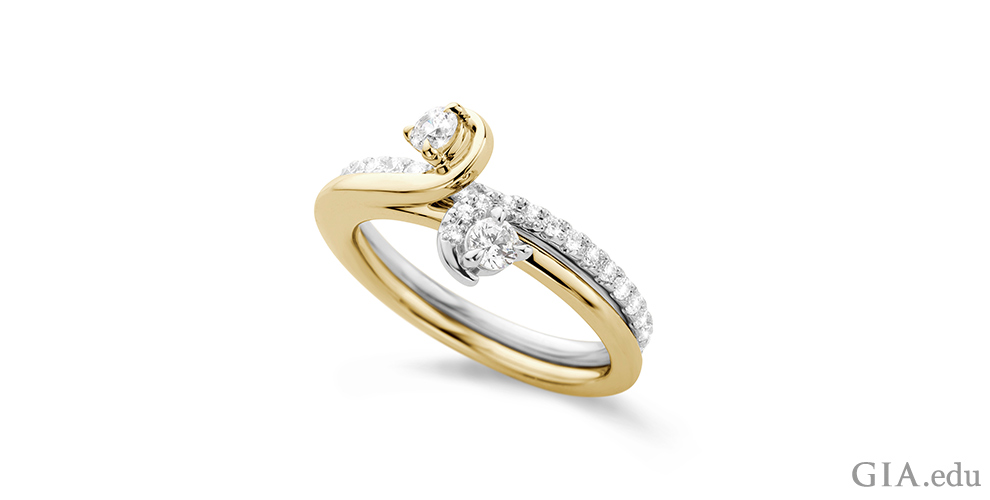Gold engagement rings are forever favorites. But how do you pick the right color gold for your ring style and center diamond? Here’s a quick breakdown on gold alloys and what to consider when making this important engagement ring decision.
In this blog, we cover:
What is gold and why is it used in engagement rings?
What gives gold its color?
Picking the right color gold for your center diamond
Picking the right color gold for your colored gemstone engagement ring
Using gold to define your engagement ring style
Mixing metals – using a combination of white gold, yellow gold and rose gold for your engagement ring
Tip Sheet: Guide to gold engagement rings
What is gold and why is it used in engagement rings?
An element on the periodic table (Au), gold is a precious metal that has been used in jewelry for more than 6,000 years. Believed to symbolize the life-giving powers of the sun, gold was used to create ornate pieces by ancient Egyptians and Sumerians. It still transfixes, making gold engagement rings a popular choice.
Why use gold in an engagement ring? In addition to being beautiful, gold engagement rings are:
- Durable: Gold is long-lasting; it is resistant to corrosion and, for the most part, it holds up well to impact associated with daily wear and care.
- Easy to manufacture and repair: Gold is highly workable.
- Affordable: Gold is generally more affordable than platinum, another metal often used in engagement rings and other jewelry.
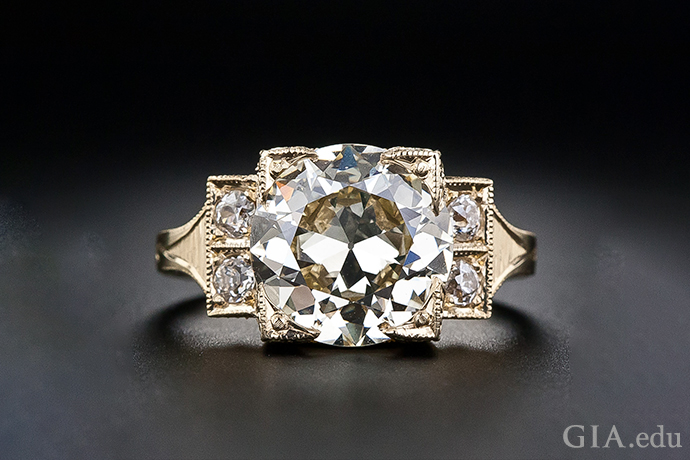
Yellow gold is the setting for this stately ring. The center stone is a 3.70 carat (ct) old European cut diamond. It is set in a contemporary 18K yellow gold mounting. Courtesy: LangAntiques.com
What gives gold its color?
Gold’s natural hue is the product of its atomic structure and the movement of electrons within that structure. This causes the metal to selectively reflect light from part of the spectrum – specifically, the red and yellow wavelengths – which combine to produce the hue we perceive as “gold.” Pure gold is too soft to be used for gold engagement rings, so it is often alloyed (mixed) with other metals such as copper, silver and zinc to make it harder and more durable. In addition to adding strength to gold, the metal alloys also affect gold’s color.
Fineness is a measure of a precious metal’s purity, and it’s based on parts per thousand (ppt). The term karat (K) is used to state the fineness of gold, with pure gold being 24 parts gold, or 24K. If a metal alloy is 75 percent pure gold, that means it is 18 parts gold and six parts alloying metals, or 18K. Because its fineness is 750 ppt, an 18K gold ring might be stamped 750 or 18K depending on regulations in the country where it was made. Similarly,14K gold is 58.3 percent gold or 14 parts gold and 10 parts alloying metal or metals, so it might be stamped 583 (or 585) or 14K. As it may be difficult to distinguish one fineness of gold from another, look for the quality mark bearing this information stamped inside the ring.
White gold is a popular choice for those who prefer white metal engagement rings. It is made by alloying pure gold with white metals such as nickel, palladium and zinc. White gold is available in many alloys, with 14K or 18K being popular choices for engagement rings. Note that white gold is usually plated with rhodium for a whiter look, a better shine and to protect against scratching. Because the rhodium can wear away over time, be sure to ask your jeweler if they will replate the ring when needed.
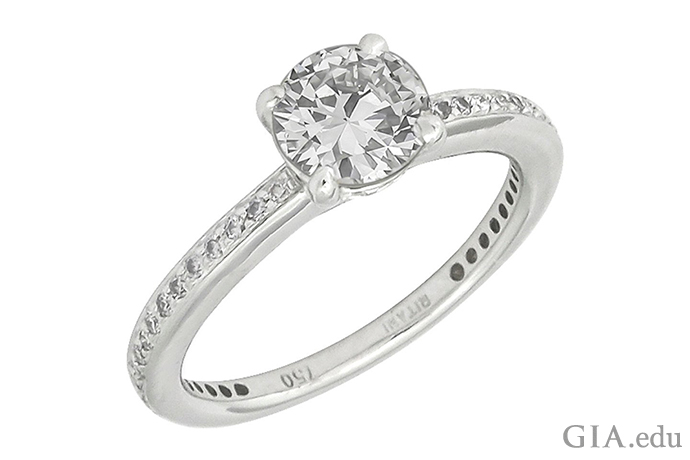
Look for the quality mark to determine the fineness of the gold in a piece of jewelry. Courtesy: 1stdibs.com
Rose gold engagement rings are a trendy choice. Rose gold is made by alloying gold with copper and silver. To create a rosy metal that charms, jewelers experiment until they find the perfect hue. Their recipes are closely guarded secrets.
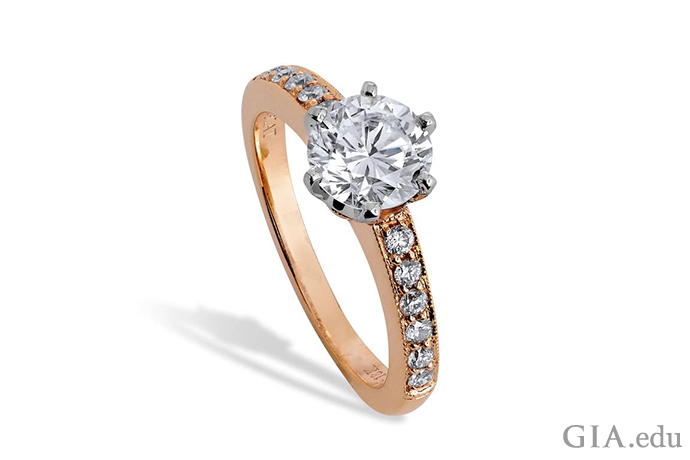
This 1.40 ct diamond engagement ring with 0.20 carats of melee is set in rose gold for a unique look. Courtesy: 1stdibs.com
Picking the right color gold for your center diamond
In diamond engagement rings, the diamond is the star of the show and the mounting is the backdrop. But using yellow gold, white gold or rose gold will affect how the diamond looks. That’s why you’ll want to pick a metal that shines a spotlight on the stone.
Diamonds are graded on the GIA D-to-Z color scale. D represents the top of the scale (a completely colorless diamond), with Z at the bottom (a diamond with an obvious presence of light yellow or brown). All things being equal, the more colorless the diamond, the more valuable it is. You can use the color grade of your diamond and the color of the gold to create different kinds of looks.
Before you start, you need to know how a diamond interacts with its surroundings. The facets on a diamond are like tiny mirrors. They reflect what is close to them, especially the color of the mounting and the prongs holding the gem. So a yellow gold mounting will produce yellowish reflections in a center diamond, a white gold mounting will produce whitish/colorless reflections in a center diamond and a rose gold mounting will produce pinkish reflections in a center diamond.
Here are some recommendations you can use when selecting a mounting.
- White gold for diamonds graded D through J:
White gold is a good choice to highlight the absence of color in a diamond. Diamonds graded D-E-F on the GIA color scale are considered colorless, while diamonds graded G through J are in the near-colorless range.
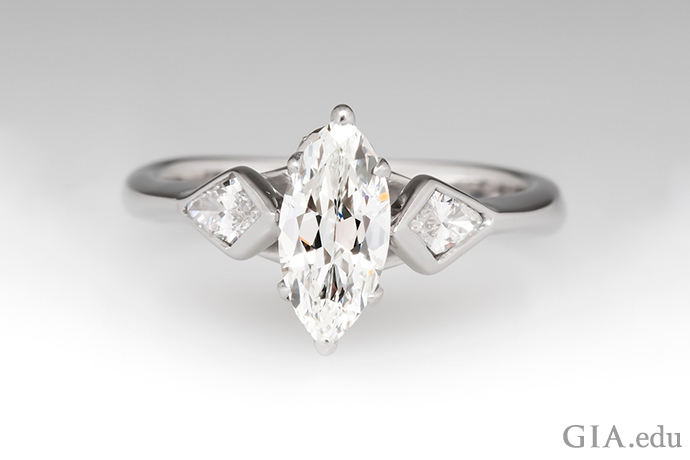
A G-color marquise diamond looks all the whiter for being set in white gold. Courtesy: EraGem.com
- Yellow gold or white gold for diamonds M and lower: A diamond with a color grade of M or lower will likely have a noticeable yellow tint. A yellow gold ring will accentuate the yellow in the diamond. Conversely, white gold may make the diamond appear more colorless.
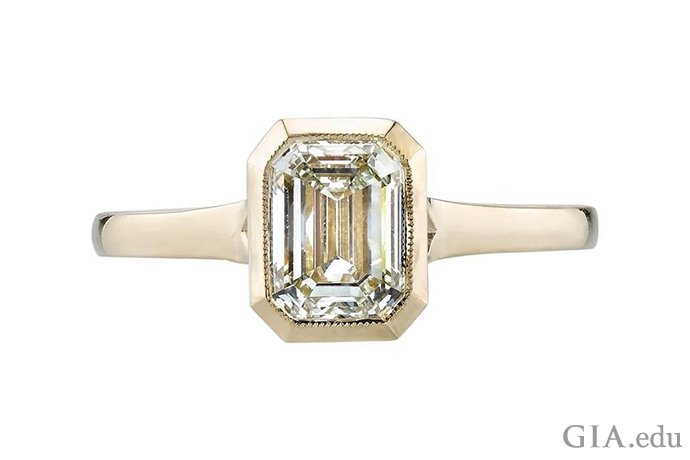
This N-color diamond is set in a yellow gold ring. The yellow gold brings out the yellowish hue of the diamond. Courtesy: 1stdibs.com
- Rose gold offers another set of options. A diamond with a color grade of D through L will pop against a rose-colored ring. Setting diamonds with a color grade of M through Z in rose gold will create engagement rings with a softer appearance.
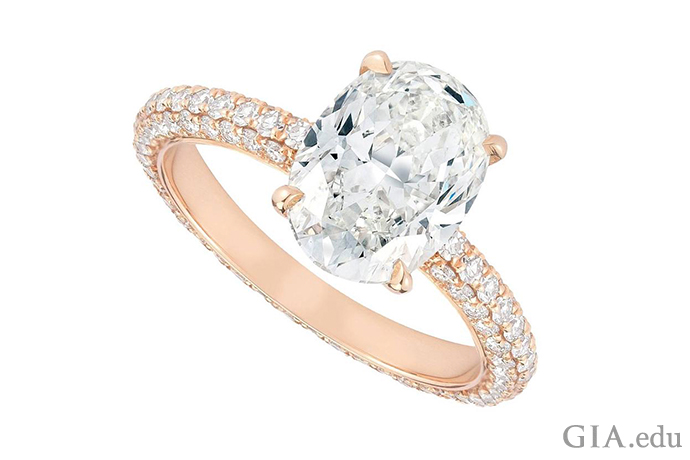
Rose gold can create lively contrast with diamonds in the D-through-L range. This ring has an I-color 2.04 ct oval diamond center stone and 118 melee diamonds adorning the shank. Courtesy: 1stdibs.com
It is not uncommon to see different colors of gold for the mounting and the prongs holding the diamond. For example, to get even more pop with a colorless diamond set in a yellow or rose gold ring, the designer will frequently use white gold prongs. For a more dramatic look for a stone low on the D-to-Z color scale, consider a white gold ring with yellow or rose gold prongs.
Picking the right color gold for your colored gemstone engagement ring
Colored gemstone engagement rings are hot – just look at the blue sapphire ring Kate Middleton wears and the padparadscha sapphire that celebrates Princess Eugenie’s engagement. With this kind of company, you might want a colored gemstone ring.
Personal preference is a good way to pick a gemstone and the right color gold mounting to set it in. But if you’re stumped, here are three tips you can use as a guide.
-
- White metals are a popular choice to highlight the color of a gemstone. Look at an auction catalog, and you’ll see the finest gems are typically set in white gold or platinum mountings.
- Cooler colored gems (e.g., blue or purple sapphire, tanzanite, blue spinel and tsavorite) pair well with cooler colored metals like white gold.
- Warmer colored gems (e.g., ruby, spessartine, morganite and Imperial topaz) pair well with warmer colored metals like yellow gold and rose gold.
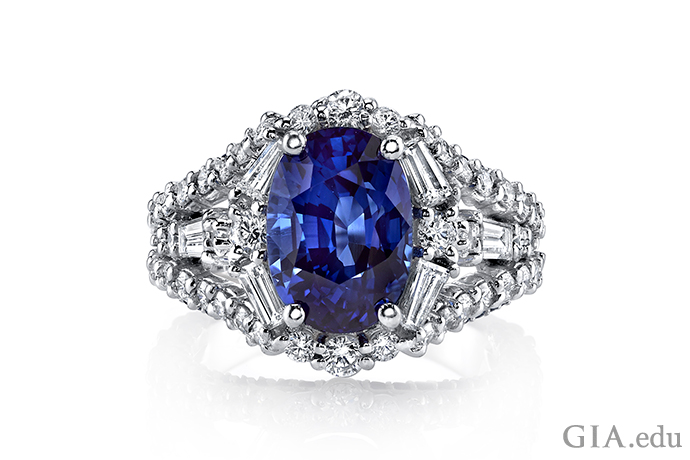
Sapphire’s blues are all the richer when set in a white gold mounting. Courtesy: evelynH Jewelry Inc.
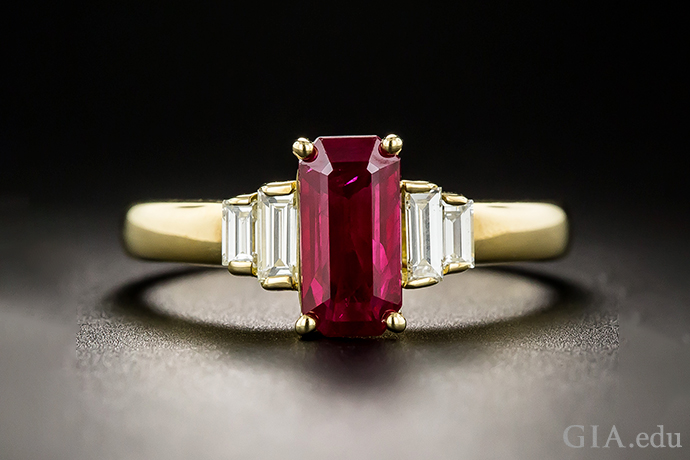
Ruby and yellow gold are a perfect pair – just like you and your soon-to-be fiancée. Courtesy: LangAntiques.com
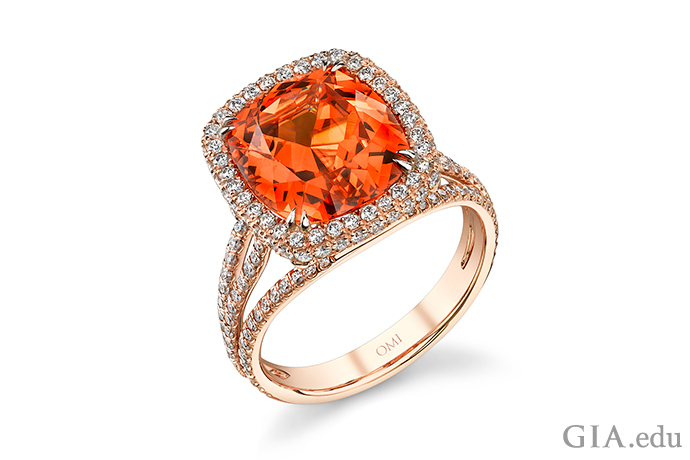
This rose gold ring holds a 7.25 ct spessartine garnet. The result is an inviting piece that would wear well in front of a crackling fire on a winter night. Courtesy: Omi Privé
Our buying guide on colored gemstones engagement rings will help you during your search.
Using gold to define your engagement ring style
Yellow gold, white gold and rose gold were popular during different historical periods. If you love the look of antique or vintage engagement rings, you can draw inspiration from these periods to create a ring style that’s both unique and romantic. Here are four periods that have influenced modern design:
- Victorian era (1837 to 1901): Yellow gold engagement rings and rose gold engagement rings were popular during the Victorian era. Jewelry designers used a number of captivating and meaningful motifs: acrostic (secret) messages, serpents (a favorite of Queen Victoria) symbolizing wisdom, flowers (roses or forget-me-nots for love, violets for faithfulness) and many more. Use these metals and motifs to create a ring style that ranges from edgy to elegant.
See examples of Victorian era gold engagement rings.
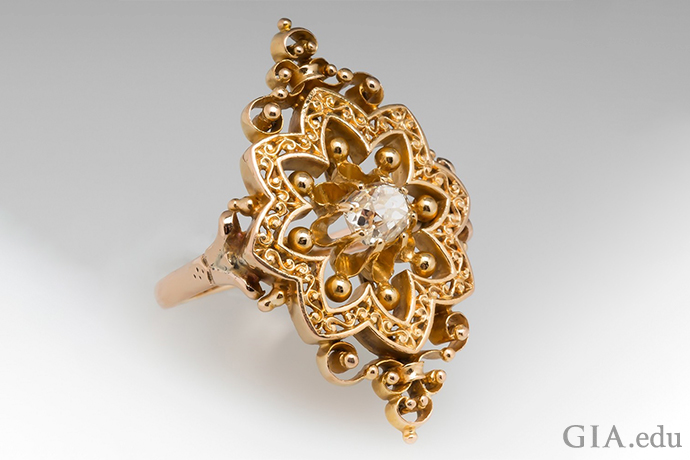
Made in the Victorian era, this ornately wrought 14K yellow gold engagement ring showcases the floral motif that was so popular during this period. Courtesy: EraGem.com
- Edwardian era (1900 to 1915): Platinum was typically used in Edwardian era engagement rings. White gold is an attractive and more affordable substitute. This period is known for motifs like triumphal laurel wreaths, scrolls, feathers, tassels, ribbons tied in bowknots and garlands of flowers. If you love a look that’s both lacy and aristocratic, an Edwardian style white gold engagement ring could be the choice for you.
Want an engagement ring that’s inspired by the period? Here’s how to get the look of Edwardian era engagement rings. Can’t decide between white gold and platinum? We compare them.
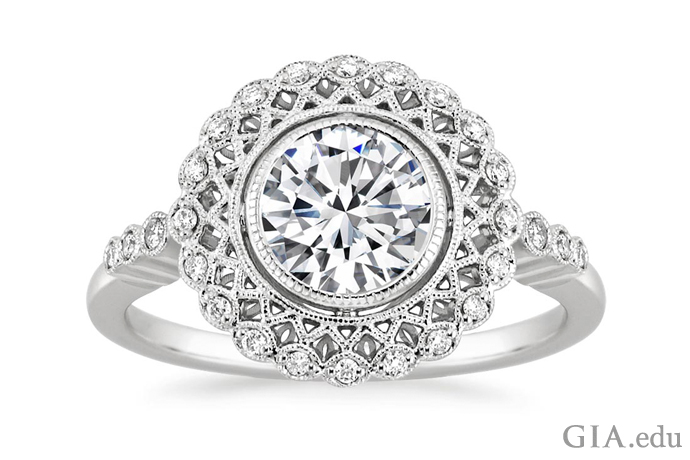
In this Edwardian style diamond engagement ring, milgrain and latticework detail provide the lacy look characteristic of this era. Courtesy: BrilliantEarth.com
- Art Deco era (1920s and 1930s): We think of Art Deco as cool and sophisticated, so it’s no wonder that white metal was popular during this period. Again, platinum was the metal of choice for fine jewelry, and white gold is a good option for re-creating these timeless designs. Motifs of the period include geometric shapes and bold color contrasts created by pairing diamonds with rubies, emeralds or sapphires. If the spirit of flappers and the jazz age speaks to you, a white gold engagement ring may be the way to go.
Here’s how to get the look of Art Deco engagement rings in your custom creation.
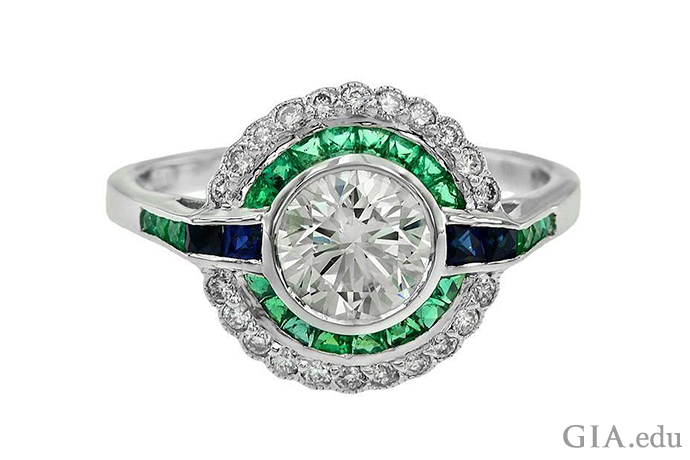
Adding bold contrasting colors and geometric patterns was a signature style of the Art Deco era. Emeralds and sapphires decorate the halo and shank of this 1.09 ct round brilliant diamond engagement ring set in 18K white gold. Courtesy: 1stdibs.com
- Retro era (1935 to 1950s): Warmth, boldness and color were signatures of this period. If you’re looking to turn heads with a yellow gold or rose gold engagement ring, definitely consider a Retro era ring style. These designs had a sculptural quality that featured bold lines and geometric shapes softened with curves. Check out this style if you want a vintage look with classic appeal.
Get more tips on creating a Retro look in your custom engagement ring.

Gold? Check. Sculptural aesthetic? Check. Rounded edges? Check. This ring has all the hallmarks of the Retro era – and demands to be noticed. Courtesy: 1stdibs.com
Mixing metals – using a combination of white gold, yellow gold and rose gold for your engagement ring
Contemporary jewelry designers have been bursting with creativity, introducing exciting new designs for engagement rings. Mixing metals is one hot trend in engagement rings. Mixing not only adds a visual burst of color to the ring, but it also allows you to set the diamond in the color gold that will bring out the very best in the gem. As mentioned earlier, one popular variation is to have the mounting one color and the prongs another. You’ll also see engagement rings with a halo of gems set in a different color gold than the ring. Or look for a double halo with one row set in a metal like rose gold and another set in white gold or yellow gold. This creates a subtle contrast that can be quite charming.
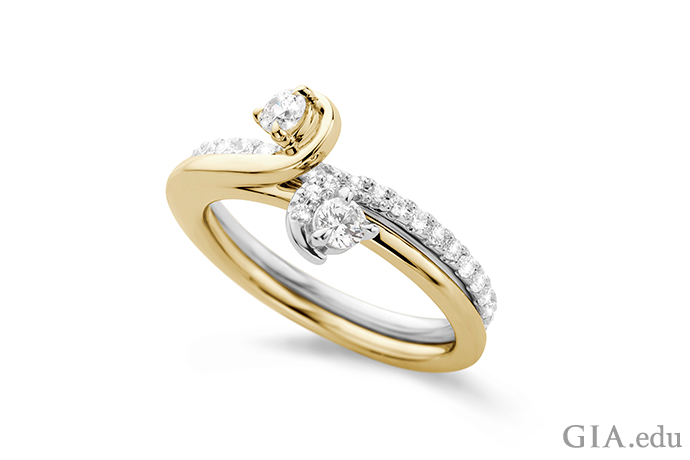
Yellow gold and white gold intertwine in this captivating engagement ring. The harmonious design suggests the joining of two lives in marriage. Courtesy: Laurence Bruyninckx – Antwerp

An 18K white gold halo is surrounded by an 18K rose gold halo. The two halos of diamond melee accentuate the 1.05 ct round brilliant cut diamond center stone. Courtesy: 1stdibs.com

You can use different colors of gold to make a serious statement – like this splashy engagement ring. A fancy pink diamond is encircled by pink diamond melee set in rose gold. A halo of yellow diamonds in yellow gold surrounds it. The outermost halo is 18K white gold aglow with colorless diamonds. Courtesy: EraGem.com
Tip Sheet: Guide to gold engagement rings
There’s a lot to consider when deciding between a yellow gold, white gold and rose gold engagement ring. We’ve condensed the important facts into a chart.
| Yellow Gold | White Gold | Rose Gold | |
| Gold alloy fineness | Alloys from 8K (333) to 22K (917) are available; 14K (583 or 585) and 18K (750) are good choices for engagement rings | Typically 9K (375), 10K (417), 14K (583 or 585) and 18K (750) | Typically 9K (375), 10K (417), 14K (583 or 585) and 18K (750) |
| Alloying metals | Copper, silver and zinc | Nickel or palladium, copper and zinc; white gold is often rhodium plated | Copper, silver and zinc |
| Care and cleaning | Avoid chlorine and harsh chemicals because they can damage the alloying metals. To clean, soak for 15–30 minutes in a solution of water and ammonia with a drop of dish detergent. Use a soft toothbrush to remove dirt and rinse with warm water. | ||
| Best for diamond colors | D through L | D–L for contrast; M–Z to emphasize the yellow in the diamond | D–L for contrast; M–Z for a more harmonious look |
| Best for gemstone colors | Warmer colored gemstones like spessartine garnet, yellow or orange sapphire and Imperial topaz | Cooler colored gemstones like blue or purple sapphire or spinel, tanzanite or tsavorite garnet | Warmer colored or pink gemstones like morganite, ruby, red spinel, pink sapphire and rubellite tourmaline |
| Best for antique or vintage design styles | Victorian and Retro look | Edwardian and Art Deco look | Victorian and Retro look |
| Allergic reactions | Avoid if you are very sensitive to copper | Avoid if allergic to copper or nickel (a common allergen); if you are allergic to one of these metals, consider platinum as an alternative | Avoid if allergic to copper |
Once you’ve decided on the color gold for your engagement ring, you may want to start thinking about your preferred diamond shape. Did you know there are seven major shapes to choose from? Our article Guide to Diamond Shapes for Engagement Rings summarizes what’s best about each shape and what to look for before you shop.
Custom Field: Array
